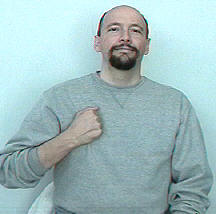American Sign Language: "Canada"
To do the sign for "Canada" thump (lightly) on your upper right chest area twice with the palm-side of your right hand. (Unless you are left handed, in which case the location is on the left side of the chest.)
CANADA:
Memory aid: The Canadian Mounted Police always get their man. The sign probably originated from the idea of a Mountie grabbing somebody's shirt. (Remember, you don't actually grab the shirt--just tap twice with the "A" hand.)
In a message dated 8/18/2005 11:23:50 AM Pacific Daylight Time, graciea@ writes:I want to ask about the sign for Canada. I've been watching our government channel (CPAC) where they have an ASL interpreter translating the question period and it seems we have a very different sign for Canada up here in ... well... Canada. I know that the signs in ASL for various countries may vary from how it is signed in that country but I'm very surprised that, with Canada so close geographically, that we didn't end up having a common sign for Canada. The sign I keep seeing on TV looks like the opposite motion of the sign 'day', with the right arm sweeping up instead of down and it is initialized, with the right hand forming the letter 'C'. Have you seen this? Would it be labeled as signed English because of the initialization? Thanks again for sharing.
-Aylene Gracie
graciea@
Aylene,
Thanks for sharing that variation of the sign for Canada. It seems to me that somewhere in the recesses of my brain I can recall having seen that sign once. But then, I don't watch much Canadian TV. I wouldn't label something as Signed English just because it is "initialized." Many people have that reaction, but if every initialized sign were eliminated we would lose many very common ASL signs like "FAMILY," "UNCLE," and "AUNT." If I happen to come across a sign for Canada or find out more information on signs for Canada done by Deaf Canadians I'll post it to my website under "Canada."Cordially,Dr. Bill
In a message dated 2/12/2006 10:29:24 P.M. Pacific Standard Time, alaidh@ writes:Dr. Vicars,
I'm commenting on the post by Aylene Gracie on your site regarding the sign for Canada. I'm not sure what she is seeing, but the only sign used for Canada is the one you have pictured, though we don't grab the shirt at all. The interpretation on CPAC is LSQ - Langue des Signes Québécoise - and not ASL but, as far as I know, the sign for Canada is the same. I'm a sign language interpreter and have worked with Deaf people for approximately 20 years and this is the only sign I've ever seen for Canada.
Thanks,
SharonSharon,
Thanks for the note. Heh, you are right...in everyday conversation the sign "Canada" doesn't "grab" the shirt. What a fascinating example of "motherese / teacher talk" in action. When teaching Hearing students, we ASL teachers often over-emphasize our signs to help the students recognize the salient features and or to function as a mnemonic device (memory helper) to sink it in.
The phrase "The Canadian Mounted Police always get their man" comes to mind. The grabbing of the shirt is iconic of the "Mountie" grabbing the criminal.
That is sort of like when ASL teachers show the signs Monday, Tuesday, Wednesday, etc. "palm forward" to their hearing classes, but do those signs palm up/back when chatting with their Deaf friends.
Now I'll have to put that on my to do list to go back and redo that sign.Take care,Dr. Bill
In a message dated 4/30/2012 6:38:42 P.M. Pacific Daylight Time,Bianca writes:
I'm from Quebec, Canada, where both ASL and LSQ (Quebec Sign Language) are used. I just want to reaffirm that the sign Aylene mentioned ("opposite motion of the sign 'day', with the right arm sweeping up instead of down and it is initialized, with the right hand forming the letter 'C'")[palm forward] is indeed the LSQ version of Canada. ASL has the same sign, but it is used to refer to the Montreal Canadians (our hockey team).
Bianca
Want to help support
ASL University? It's easy:
DONATE (Thanks!)
(You don't need a PayPal account. Just look for the credit card
logos and click continue.)
Another way to help is to buy something from the ASLU "Bookstore."
Want even more ASL resources? Visit the "ASL Training Center!" (Subscription
Extension of ASLU)
CHECK IT OUT >
Bandwidth slow? Check out "ASLUniversity.com" (a
free mirror of
Lifeprint.com less traffic, fast access)
VISIT >
You can learn
American Sign Language (ASL) online at
American Sign Language University ™
Lifeprint.com © Dr. William Vicars





